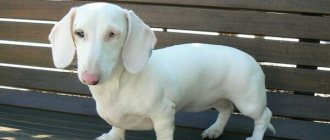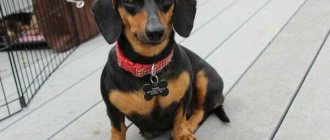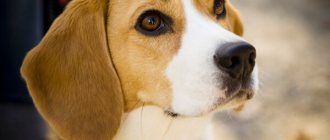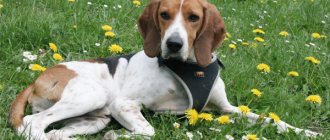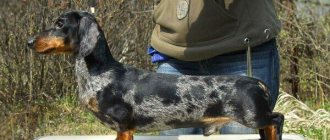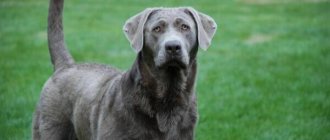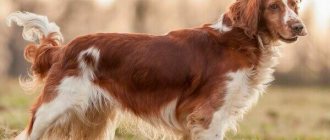Beagles are one of the most popular dog breeds.
These small, hardy dogs with a positive and friendly character are used not only as hunters, but also as pets.
And beagles, thanks to their sensitive sense of smell, are quite successfully used by intelligence agencies as bloodhounds.
But, despite the popularity of this breed, not everyone knows what a beagle looks like.
Meanwhile, it would be useful for people who want to have such a pet to learn about its external characteristics and how purebred dogs differ from crossbreds.
Brief history of origin
The history of beagles dates back to Ancient Greece, where their ancestors were already used during hunting . The duty of those dogs was to track game by scent, which they successfully did.
Later, the Romans became interested in them and began breeding them. And so the ancient Romans fell in love with the Greek hounds, so much so that when they set off to conquer Britain, they took their hunting dogs with them.
Once on the territory of Foggy Albion, the Roman hounds quickly got used to the new conditions of existence and began to actively crossbreed with local hunting breeds, so that in the end it was as a result of this mixing of the blood of Roman and Anglo-Saxon breeds that the first of the modern beagles were born.
There is another version of the origin of the breed, according to which dogs similar to the beagle already existed in Britain even before the arrival of the Romans . And some experts consider their ancestors to be the white hounds from the pack of the Prince of Wales, Pwyll, who lived at the same time as the legendary King Arthur.
Throughout the Middle Ages, small hounds were used to hunt rabbits and other small game. Beagles began to be considered a separate breed in the 18th century. And the first beagle breed clubs in America, where these dogs gained great popularity by the end of the 19th century. However, the modern breed standard appeared only in 1957.
To date, beagles are being used less and less for their intended purpose - as hunting dogs . Now this is more of a companion dog - smart, good-natured, active and very playful.
Health
Characteristic diseases
Beagles are in good health and do not suffer from eye diseases such as cataracts or allergies .
However, they may be susceptible to the following diseases:
- Dermatitis;
- Diabetes;
- Lymphosarcoma;
- Intervertebral disc disease;
- Epilepsy;
- Hepatitis.
Beagles on walks constantly sniff the tracks, burning with the desire to follow any of them.
Vaccinations
Vaccination schedule :
- 1st dose at 8-9 weeks
- 2nd dose at 11-12 weeks
- 3 dose at 14-16 weeks
- Revaccination at 1 year
Every year you need to be vaccinated against rabies, and every three years you need to be vaccinated against leptospirosis, parainfluenza, parvovirosis, hepatitis and plague.
Beagles are perfect hunting dogs and therefore require serious exercise and play.
Description of the pet's character
With proper upbringing and socialization, a beagle does not experience aggression towards strangers, not to mention the person with whom he lives.
But a highly developed hunting instinct makes it difficult for this dog to interact with other pets, although not all of them: a beagle can get along in the same house with another dog or cat, but it is unlikely to tolerate the presence of rodents or mustelids.
For the same reason, a beagle, indifferent to its own domestic cat, may chase someone else’s cat on the street, unless, of course, it is on a leash at the time.
The Beagle is considered one of the most escape-prone breeds . That is why you need to take him outside only on a leash, and let him run only in a fenced area.
If the pet is kept in an enclosure or in the courtyard of a private house, then it is necessary that the fence be well deepened, since these dogs are very good at digging under fences.
At home, the beagle is affectionate and friendly: he plays wonderfully with children and has an affectionate disposition.
Upbringing
There are opinions about the Beagle breed that it is highly trainable and suitable for beginners. But this is nonsense. Not a single hound has ever been brought up easily.
English Beagles are stubborn and easily distracted during training. Moreover, they only do it when they want to. If dogs are full, tired or not in the mood, they will never get up from a comfortable sofa.
Like any hunting dog, the beagle makes its own decisions. What is the command “Come to me” or “Sit” when the nostrils are tickled by the seductive smell of a dove!
The Beagle is a dog with poor perseverance. It is difficult for her to concentrate on the owner and maintain attention for a long time. At the same time, the pet is smart and cunning. He constantly deceives people, knows how to manipulate and press for pity.
The main assistants in training beagles are treats and toys. It is impossible to strictly punish, let alone beat, dogs - they will become fixated on failure and refuse to follow orders.
They raise an English beagle from the first day they are in the house. It is important that the dog learns basic commands before puberty: an ill-mannered pet, coupled with surging hormones, is uncontrollable. It is difficult even for an experienced dog handler to correct his behavior.
Beagles are trained according to the following scheme:
- from 2 months they are taught the basics of education;
- at 3-6 months they are enrolled in a general education course;
- after six months - to a general obedience course;
- from 6-8 months – for a general training course;
- from 8-9 months they engage in training with the beagle, teach them to work on the scent in the forest and field.
Breed standard
The Beagle is a medium-sized but strong dog with well-developed bones (shown in the photo).
The head is proportional, noble lines, typical for hounds.
The occipital protuberance is well defined, the forehead is quite voluminous, somewhat rounded with a noticeable vertical groove. The stop is well marked, but not abrupt. The muzzle is of sufficient length: its length should be in relation to the skull as 1:1, but even longer is preferable.
The muzzle is rectangular in shape, with a straight bridge of the nose. The lips form noticeable jowls. The teeth are straight, scissor bite.
The nose is quite large, black or brownish (in dogs with light coloring).
Eyes with an intelligent expression, not too large, but not small either, medium set. Eye color can be one of brownish shades. The ears are long, soft, and set rather low. When calm, they fall in light folds along the animal’s cheekbones, and if you pull the ear forward, its edge should reach the tip of the nose.
The chest is quite wide, oval in shape, reaching to the elbows. The neck is of medium length, the back is level and not too short, the croup is sloping. Limbs straight, parallel and strong. At the same time, the hind legs are more muscular than the front legs. Paws are arched, rounded, with curled toes.
The tail is quite thick, in a state of rest it is held on the line of the back or even lower, and in excitement it is raised almost vertically.
The coat is thick, lying close to the body, with a well-developed undercoat.
Beagle fur has the ability to self-clean itself from dirt or dust..
Read more about the Beagle breed standard here.
Possible diseases of the beagle
Beagle dogs expend a lot of energy as they spend most of the day on the move. And, since the beagle is one of them, he needs a diet. Hunting dogs love to eat. They will feast on any food that is in their bowl. Unfortunately, some careless owners, indulging the animal’s weakness, overfeed it.
Fat beagles cannot quickly run after prey, they are less active and often suffer from gastritis and other diseases of the gastrointestinal tract. Therefore, to maintain your pet's digestive function, do not allow him to overeat. An adult dog's bowl should be filled twice a day, not more often.
To prevent infections from entering your dog's body, regularly remove wax from his ears. If you notice that she is constantly scratching her large ears, they are probably inflamed. Take your dog to the vet so he can prescribe drops. You can pour them in yourself. Although, there is a possibility that the inflammation will go away after the first ear cleaning.
Be sure to give your beagle medicine for worms and fleas twice a year, especially if he spends a lot of time outside. And lastly, don’t forget about maintaining his immunity. He should receive nutrients not only from food, but also from fortified tablets for dogs.
Types of animals
Modern beagles are divided into European and American.
At the same time, European dogs are smaller in size and have a somewhat miniature build.
European
- French (Beagle Harrier): Larger than the standard Beagle, its height ranges from 38 to 48 cm and weight up to 20 kg. They were bred by infusing Harrier blood. A notable feature of this variety is its strong bone structure and medium-sized V-shaped ears.
- English beagle. It is considered the oldest and classic variety. The height, weight and build of these dogs correspond to those specified in the standard.
- Kerry Beagle. The largest of all European varieties of this breed: height is 55-56 cm, and weight is 20-27 kg. The most typical color of the Kerry Beagle is saddleback.
American
These dogs differ from European beagles in their larger size (except perhaps shorter than the Kerry).
Also among their distinctive features are a somewhat angular head shape and a more muscular build than classic dogs.
Of all the above varieties of the breed, it is the English beagles that are considered to be the most consistent with the breed standard (shown in the photo).
Reproduction
It is recommended to engage in mating on the 7-10th day of the female's estrus. When choosing a male dog for mating, the following factors must be taken into account:
- characteristics of character and psyche;
- pedigree;
- compliance with breed standards.
You can understand that a dog has become pregnant after mating by the following signs:
- calm behavior;
- abdominal enlargement;
- expansion of the ribs;
- increased appetite.
A pregnant dog needs to be looked after carefully. Particular attention should be paid to the diet. The dog should be fed vitamin and mineral supplements.
Popular shades
Tricolor : black and reddish-fawn spots located on a white background. If black predominates, then this color is called saddleback, and if white, then shiny. Black and red, interspersed, are called variegated color.
Bicolor : with this color, spots of lemon, red, red or even chestnut shades are located on a white background. Black and white bicolor is also found, but extremely rarely, since black color is not typical for this breed.
White : According to the breed standard, pure white is acceptable, but there should be no signs of marking, although marking is not considered a fault in other colors.
Black : Extremely rare and usually combined with small white markings.
In general, any color typical of hounds is considered acceptable for beagles, with the exception of chocolate, also called liver.
Nutrition
You should feed your pet in moderation; you should not trust the sad eyes of a “hungry” dog. For food, you can choose professional food or natural food.
In the second option, the share of meat products should prevail over everything else. You can try giving dairy products, but they may cause stomach upset. Vegetables and fruits will be a pleasant addition and a source of vitamins.
What puppies look like
Even small Beagle puppies that are just starting to walk on their own look like smaller versions of adult dogs, except that babies have shorter and thicker legs and in general they look not so much muscular as plump.
Small beagles' heads look somewhat larger than those of adult dogs.
NOTE!
The color of puppies changes little with age: a tri-colored puppy cannot become white or two-colored.
But the color of the spots may become more saturated with age or, conversely, lighten a couple of tones.
Interesting Facts
Some interesting facts about beagles include the following:
- in England these dogs are still used for hunting;
- in some countries, representatives of the breed are used to search for explosives and drugs;
- such dogs are often invited to film films;
- Little beagles are very cultured and intelligent animals.
The Mini Beagle is a small dog that is especially popular among dog breeders and hunting enthusiasts. Before getting a dog, you need to familiarize yourself with the description of the breed and the peculiarities of keeping it at home.
What crossbreeds are there?
Puggle (beagle+pug)
These dogs look like pugs with a long, wrinkled muzzle and drooping ears. Their tail is curled into a complete or partial ring and looks thinner and longer than that of a pug. The color is most often fawn with a black mask.
Cheagle (beagle+chihuahua)
These dogs are smaller than beagles and have lighter bones. Their ears are not so long, and their muzzle is not rectangular, but rather pointed. The color can be any depending on the genotype of the puppy, but the most common are bicolors and saddlebacks of varying intensities.
Jack-e-bee (beagle + jack russell)
The build is more similar to a Jack Russell, but at the same time these dogs have rather large, floppy ears - almost like a beagle. The most typical colors: bicolor, tricolor.
To understand what traits a puppy can get, read the comparison between Beagle and Jack Russell.
Beagle+basset hound
Outwardly they resemble a beagle with a very high elongation index for this breed, or an old-type basset hound - just like in old paintings and engravings.
Beagle+spaniel
They are similar to beagles, but their fur is longer and softer, although they do not form feathering on the ears and limbs, like a spaniel. Color - any of those that are typical for any of these breeds.
Beagle+dachshund
Depending on whose genes are stronger, the puppies may look like either a dachshund with slightly taller legs, or a beagle with shorter limbs.
Crosses of beagles with other breeds of hunting dogs were bred not out of the desire of breeders to see what would happen as a result of such mating, but to improve working qualities.
For example, mixed breeds with a spaniel swim willingly, while a purebred beagle is reluctant to go into the water.
Care and maintenance
Since the dog is not impressive in size, it can be kept both in a house and in an apartment without any problems. This is also due to the fact that their maintenance and nutrition does not require a special approach. It is very important that the animal moves as much as possible. Therefore, this dog is not for the lazy and not for homebodies, but for those who are ready to walk for a long time with their pet.
Care and hygiene
You will have to monitor the condition of your dog's eyes and ears every day. When returning from a walk, wipe the animal's paws with a damp towel.
It is enough to brush the animal 2 times a week, but during periods of shedding you will have to do this more often. In addition, dead undercoat is removed with a special brush.
Beagles bathe quite rarely, only in cases when the pet gets dirty in something sticky and smells terrible.
The eyes and ears are also cleaned as they become contaminated with dirt or natural secretions in excess.
As a rule, the claws of these animals wear down as the dog is active, but if this does not happen, then the claws are trimmed with a nail clipper.
Need to know! Beagles do not require special dental care, although they should be provided with special toys or treats that will help the dog get rid of plaque.
What to feed
These dogs always have a great appetite because they actively burn calories. As a rule, there are no problems in this regard. The most important thing is to decide what kind of food to give the animal: you can feed the dog with natural food, or you can feed it with high-quality ready-made food.
It should be remembered that natural food is not food from a person’s table. It must be prepared separately for the dog, observing the proportions of the food components, with a small amount of salt (under-salted).
The percentage of meat products should be at the level of 30 percent and no less for pets, and for working dogs this proportion should reach 50 percent.
The rest of the daily diet includes various cereals, vegetables, both raw and boiled, greens, as well as fermented milk products. Once a week, the dog can be pampered with a boiled egg, as well as fish, replacing meat with it, and there should be twice as much fish as meat in order to maintain the energy value of the diet.
Puppies up to 3 months of age need to be fed about 6 times a day, and at six months - no more than 4 times. When the animal reaches 1 year, the dog is fed no more than 2 times a day.
Need to know! Adult beagles are prone to gaining excess weight, so the daily diet is divided into a maximum of 3 parts.
Beagle breed


